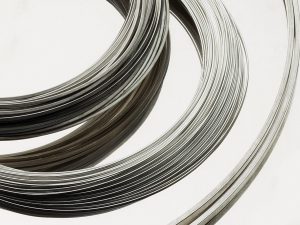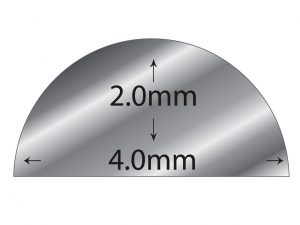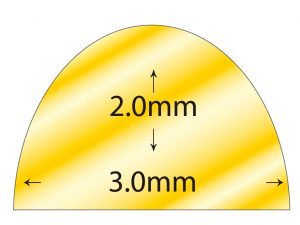
Precious metal wire is an essential component of jewellery making. Gold and silver wire is used to create a range of finished pieces, findings and other components. For beginner jewellery makers it is advised to practice techniques on base metal wire options which include copper and brass before moving up to working with gold, silver, platinum and palladium wire.
Before working with wire it is important to understand the gauge and size options available to you as well as the different shapes.
Round Wire – is your basic, everyday essential material that virtually no workshop can do without. The size range is the broadest across all of the wire products and spans an impressive 0.2mm – 19mm. The thinner the gauge, the more pliable the material so you will find anything under 1mm extremely easy to bend with hand tools, whereas anything above this will require a little more force. Once you get beyond 2mm a hammer will be required to change and alter the shape along with plenty of annealing to keep things moving along.
The lightest gauges of round wire are used for cloisonné enamel work, filigree and jewellery repairs whereas 0.8mm is perfect for making your own findings such as jump rings, ear wires and posts. 1mm, 1.5mm and 2mm are our best selling sizes of round wire and form a good basis for a new workshop. These wire sizes have more strength to them and can be successfully hammered and forged into rings, bangles and neckpieces plus just about everything else in between.
Once you get over 3mm, things become a little more specialist and infinitely more expensive. These bigger gauges can be used for more heavy duty silver smithing, sculptural work and machining which is why they are supplied in ‘fully hard’ condition to make them easier to handle. Machining silver using a lathe is an extremely skilled process only to be undertaken by professionals and not to be taken lightly.
Cooksongold have a huge selection of round wire available in copper, brass, silver, 9k, 14k, 18k, 22k and fine gold, palladium and platinum which can all be supplied and cut to your requirements so the sky really is the limit!
Shaped Wire – Once you have your basic round wire stock in place you might want to consider some other shapes. D-shape wire is our second biggest wire category after round. D shaped wire is a great choice of wire for rings, bangles and earrings. To ensure the perfect join, shaped wire must be cut cleanly using a saw making sure the two sides are completely square and parallel. It’s worth taking the time to do this correctly otherwise you will forever be staring at an imperfect seam


9ct Medium White D Shape Wire 4.00mm X 2.00mm, 100% Recycled Gold – LAR 420 and 9ct Yellow DF D Shape Wire 3.00mm X 2.00mm, 100% Recycled Gold – LAA 300
As you can see from the images above, the dimensions of D-Shape wire vary, so be sure to consider the depth of the profile you need before ordering.
Square wire is beautiful and can provide a myriad of design opportunities. Held in a vice, it can be twisted using a pair of parallel pliers to create beautiful and decorative corkscrew sections which can then be used for bangles and is also a great choice of wire for rings, edging for boxes and napkin rings etc. It is so easy to work with once annealed and looks really effective. As with the round wire, if you are unsure and simply want to experiment, 1mm, 1.5mm and 2mm will provide a good starting point but the range spans 0.8mm – 8mm in its entirety.
N.B. To protect the edges of your square wire during shaping, use pliers with soft jaws or stick to parallel pliers where possible.
Once you have the basics covered there are other shapes of jewellery making wire to explore include rectangular, oval, (again ideal wire for rings and bangles) patterned and decorative strips. New styles are added regularly so it’s worth keeping an eye on the website so you don’t miss out.

Cooksongold
